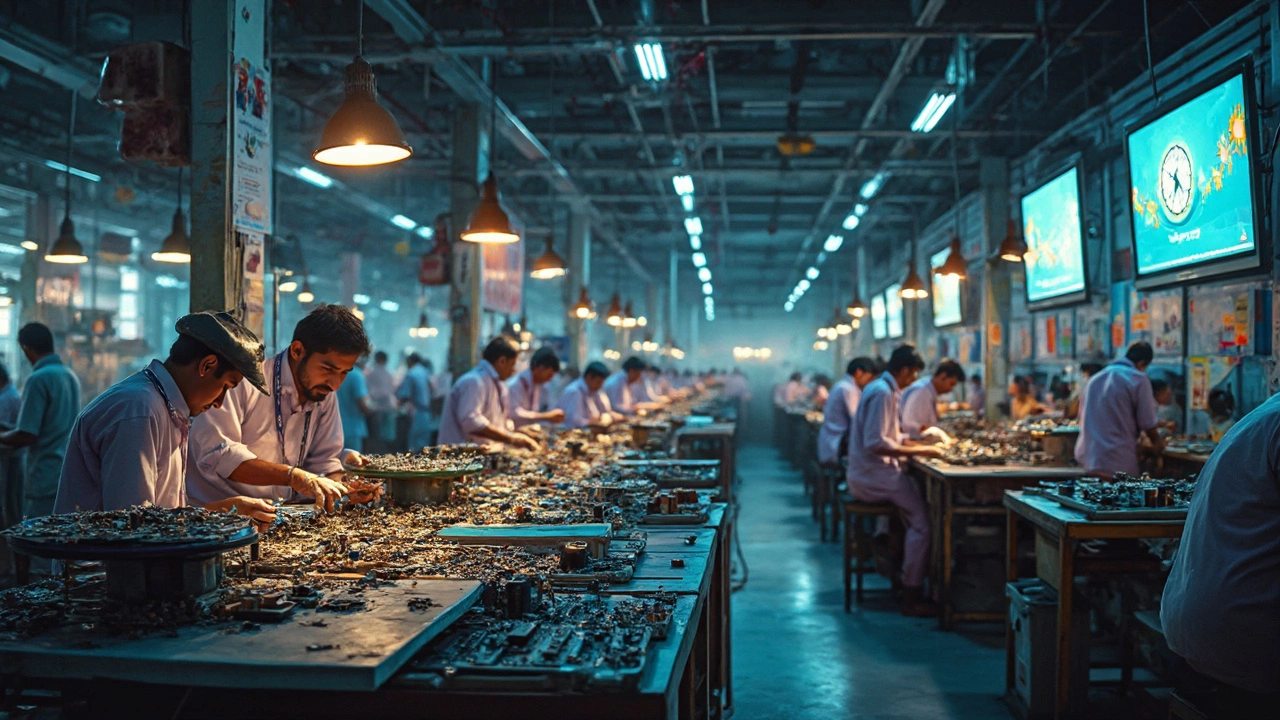Ever wonder which manufacturing sectors bring in the highest profits? It's not just about making stuff; it's about making the right stuff at the right time. Today, sectors like electronics manufacturing and the pharmaceuticals industry are leading the pack.
Why electronics? Well, think about what's in every hand and home—smartphones, laptops, and smart devices. People love their gadgets, and companies love the profits. The constant demand for new tech and upgrades keeps this industry thriving.
Then there are pharmaceuticals. We all need medicine at some point, and the development of new drugs is both a challenge and an opportunity. With aging populations worldwide, this sector only looks more lucrative.
But don't count out newer trends like green technologies. Solar panels, efficient batteries, and eco-friendly products are gaining traction, promising not just profits, but a future-friendly business model.
Diving into manufacturing requires savvy decision-making. Low startup costs and high demand can be a sweet spot, so keep those in mind as you consider which industry suits you.
- Electronics Manufacturing
- Pharmaceuticals Industry
- Emerging Green Technologies
- Practical Tips for Startups
Electronics Manufacturing
When it comes to electronics manufacturing, we're talking about a sector that's pretty much the backbone of modern life. The demand for electronics isn't slowing down—it's speeding up! From smartphones to smart homes, the market is buzzing with opportunities.
Why is electronics manufacturing so profitable? For starters, think about the life cycle of gadgets. New models come out yearly, and folks are eager to snag the latest upgrades. Plus, tech companies constantly compete to outdo one another with features, creating a robust cycle of innovation and demand.
Key Players
Some of the giants like Apple and Samsung have built mighty empires in this space. They set the trends, drive innovation, and most significantly, push consumer expectations higher with each release. Joining their supply chain can be hugely lucrative, providing components or products directly to these household names.
Components Demand
It's not just about finished products; the demand for components like microchips, sensors, and other high-tech components is off the charts. Manufacturers who specialize in these can enjoy impressive profit margins. Take the recent chip shortage—you might have heard about how it impacted everything from cars to consoles. It's a reminder of how critical and profitable this sector is.
Challenges and Opportunities
Of course, electronics manufacturing isn't without its hurdles. Rapid tech advancements can make products obsolete quickly, and sustainability is becoming crucial as e-waste concerns grow. Still, tapping into trends like greener electronics or more efficient recycling processes offers a ton of promise.
Emerging markets are another opportunity. As more regions ramp up their tech access, smaller players can carve out niches by catering to these new tech users. Keeping an eye on these changes can guide smarter investment and innovation strategies.
Taking a step into electronics manufacturing means entering a fast-paced, ever-evolving world. Stay ahead by keeping your ear to the ground on new tech trends and consumer behaviors, and remember—innovation is the name of the game here.
Pharmaceuticals Industry
The pharmaceuticals industry is a powerhouse in the world of manufacturing. Got medicines? Of course, you do! Everyone needs them, which makes this industry indispensable. But beyond just necessity, it's the innovation and high demand that keep it so profitable.
What's Behind the Profit?
Pharmaceuticals thrive on research and development (R&D). Drug companies spend billions creating new formulas and solutions. While this might sound like a huge investment, the returns are significant when they hit the market with a breakthrough. That's why you see companies investing heavily in R&D—an effective strategy for long-term gains.Essential Factors Driving Growth
We're living longer, and that's good news for pharma businesses. Aging populations across the globe mean more demand for chronic illness management drugs. Additionally, the recent focus on personalized medicine, which tailors treatment to individual genetic profiles, is pushing the industry's boundaries.Regulation and Challenges
Of course, it's not all plain sailing. Stringent regulations and the long FDA approval process in the U.S. can be costly and time-consuming. However, the rigorous standards ensure safety and efficacy, which maintain consumer trust—it’s a double-edged sword that firms must navigate.Entry Tips for New Players
Thinking of getting into pharma? Consider starting with over-the-counter (OTC) drugs or health supplements. They’re often easier to produce and don't require as extensive an approval process as prescription meds. Partnering with research institutions can also provide valuable insights and innovations.Let's peek at some data, giving you a clearer picture of the market:
| Year | Global Pharma Market Value (USD Billion) |
|---|---|
| 2023 | 1,341 |
| 2024 | 1,426 |
| 2025 | 1,517 |
Notice how the market just keeps growing? That's a glimpse into why the pharmaceuticals industry is such a lucrative manufacturing sector. It's complex but offers rewarding opportunities for those ready to tackle the challenges.

Emerging Green Technologies
Green technologies aren't just a buzzword; they're where the future is headed. As we become more aware of our impact on the environment, manufacturing driven by sustainability is more crucial—and profitable—than ever. Think solar panels, wind turbines, and efficient batteries. These are reshaping the energy sectors and offering sustainable solutions with strong market demand.
Solar Power: Harnessing the Sun
Solar power companies are popping up worldwide, from large-scale solar farms to small rooftop systems. Improved efficiency in solar panels means they're not only cheaper to produce but also more effective at generating energy. With government incentives and declining production costs, stepping into solar manufacturing can be a smart move.
Wind Energy: Catching the Wind
Wind energy is another area booming with potential. Much like solar, there's a demand for greener energy sources created by these giant turbines. If the wind is blowing—and it usually is—then your product can continuously generate electricity. Offshore and onshore wind farms require robust equipment, and manufacturing these components offers hefty returns.
Battery Technology: Powering the Future
Now, let’s talk batteries. The rise in electric vehicles and renewable energy storage solutions means innovative battery tech is crucial. Solid-state batteries, in particular, are all the rage due to their higher energy density and safety advantages. Companies diving into this sector are set for growth.
In case your business decisions depend on cold hard numbers, here’s a useful tidbit:
| Technology | Estimated Annual Growth Rate (2025-2030) |
|---|---|
| Solar Power | 20% |
| Wind Energy | 15% |
| Battery Technology | 25% |
By focusing on manufacturing within these sectors, you're not just lining your pockets; you're also contributing to a healthier planet. As with any business, keeping an eye on evolving tech and regulations will help ensure you're at the front of this green wave.
Practical Tips for Startups
Stepping into the manufacturing world can feel like jumping into the deep end, but don't worry, I've got some practical tips to help you make a splash.
Understand Your Market
Before anything else, know your audience. Research companies similar to yours to figure out who’s buying their products. Markets are not a one-size-fits-all, so get to know the nuances of the specific industry you're entering. For instance, if it's electronics, be aware of tech trends and how rapidly they change.
Focus on Costs
Money matters. Learn about raw material costs and supplier relationships. Buying in bulk can reduce costs, but balance that with your storage capabilities. Remember, the price of business ideas isn’t fixed; negotiate like a pro to get the best deals.
Embrace Technology
Use digital tools to streamline operations. Automation in production lines can do wonders for efficiency and accuracy. In the pharmaceuticals sector, for example, precision is key, and tech helps achieve that.
Compliance and Regulation
Don't ignore the red tape. Each industry has its own rules to follow. Especially in sectors like pharmaceuticals and green technologies, compliance with health and safety standards is crucial. Non-compliance can ruin your business before it even gets started.
Build a Strong Team
Your team is your backbone. Hire people who are not just skilled, but are passionate about the field. Train them well and foster a collaborative environment so they're motivated to drive your startup forward.
Getting Feedback
Customer feedback is gold. Use it to improve your products and processes continuously. Whether you're in green technologies or electronics, evolving with consumer needs ensures you stay competitive in the market.
By taking these steps, you'll be better equipped to navigate the startup journey in the manufacturing sector. The goal is clear: make informed choices that align with high-demand markets, and you've got a recipe for success.
